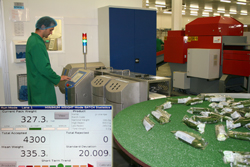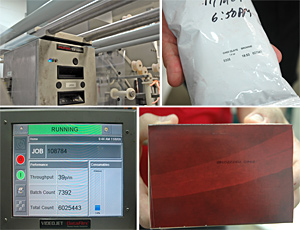
Keystone Foods acquisition fuels Mafrig's growth
Marfrig, a diversified food company producing a variety of meats, began business in 1986. In January, Marfrig concluded the acquisition of Cargill Inc.’s entire Brazilian animal proteins business (poultry, hogs and industrialized products), represented by Seara Alimentos Ltda. and by affiliates in Europe and Asia, including the SEARA brand in
Keystone Foods, the largest US privately held meat products company-according to Forbes’ 2009 American’s Largest Private Companies-is headquartered in West Conshohocken, PA and serves more than 28,000 restaurants in 13 different countries. In 2009, Keystone had 12,900 employees in 54 units and net revenues of $6.4 billion on its food production and distribution business.
According to Marcos Molina, Marfrig Group chairman and president, “The global food market is growing and
“We are very excited about the opportunities that this transaction creates for Keystone Foods and Marfrig,” says Keystone Foods CEO Jerry Dean. “Bringing these two world-class companies together will benefit our customers and our employees globally. Keystone Foods has grown its proteins manufacturing and custom distribution business to become a diversified food company with global operations and reach. This platform along with Keystone’s years of expertise will provide new and attractive opportunities for Marfrig with major food service and industrial customers worldwide,” he adds.
Keystone Foods’
Flooded plant reopens in 11 days thanks to team spirit
Barker and Mofield placed sandbags at the entrances as a precaution and were cautiously optimistic that rising waters would not reach the plant. Twenty minutes later, both men and Plant Manager Charles Crutchfield, who had just arrived, were standing in the plant’s kitchen, waist deep in water. According to Crutchfield, even though some equipment was located high enough that it escaped the waters, plenty of compressors, vacuum pumps, boilers, motors, gearboxes and other equipment were soaked-including computing equipment. Fortunately, electrical service to the building was not interrupted.
Tennessee Governor Phil Bredesen declared a state of emergency as floodwaters destroyed homes and closed highways, churches and other facilities in the center of the state. Crutchfield, with the help of Barker, Production Manager Terry Gooch, Supervisor Monroe Odem and QA Manager John Phelps, attempted to call each plant associate, confirming they were safe and advising them about the condition of the building. Every associate, totaling 115, was confirmed safe-though that could not be said for some of their homes, which suffered extensive damage or were lost.
The rain and majority of the flooding left the area just as quickly as it had arrived, leaving behind a plant and office facilities that were badly damaged by the end of Sunday night.
Though many homes and vehicles were totally destroyed, many associates began arriving Sunday night to ask what they could do. “Here we had associates, many of whom had experienced their own significant damage to their homes and personal property, coming in to ask us if we needed help,” says Crutchfield. “It shows just how dedicated and passionate these associates are about their plant and our company,” he adds.
By Monday morning, Crutchfield and his leadership team had a plan in place and a team of associates assembled to start the clean-up effort. Seventy-five associates worked a total of 5,653 hours-around-the-clock, 12-hour shifts-cleaning and repairing the entire facility to get it back on line. Drying out affected motors, cleaning and re-lubricating gearboxes and cleaning and sanitizing every inch of the plant and its equipment took 11 days-far short of the month to 45 days the USDA and Rich’s Manager of Global Food Safety Dennis Edwards predicted it might have taken.
According to Edwards, 400 different locations across the plant were tested to ensure environmental and product safety, and every one of the 400 tests gave the green light. Thanks to help from associates and the maintenance department from Rich’s corporate location just 45 minutes away, the plant was up and running in 11 days.
In addition, associates, with corporate matching funds, raised more than $50,000 to help 14 fellow associates who lost almost everything in the flood.Automation News

Produce grower finds magnetic solution
The aim of this model greenhouse is to bring high-intensity horticulture to the
To meet the high demand and tight supply schedules, Thanet Earth required a fast, efficient and reliable checkweigher and metal detection solution. Loma Systems’ CW3 checkweighers and combination CW3 checkweigher/IQ3 metal detection system were chosen after careful evaluation.
According to Chris Whitehead-Collet, Thanet Earth operations director, “Loma had the competitive edge when it came to technical specification and expertise during the supplier evaluation. He continues, “By partnering with Loma Systems, we now have the peace of mind that the equipment is able to withstand our product levels.”
The checkweigher was easily integrated into Thanet Earth’s high-speed lines and, with belt speeds up to 120 m/min., can easily cope with the high throughput of the cucumber, tomato and pepper production lines. The checkweigher withstands tough industrial environments and meets IP69K washdown specifications.
A significant percentage of Thanet Earth’s business is serving major supermarkets. The space-saving checkweigher and metal detector combination satisfied the company’s demanding production schedules. The checkweigher is easy to set up and adapts to a wide range of different products, which is essential for Thanet Earth and its variety of fresh produce. The system reduces downtime and allows the producer to operate at the highest speed while also meeting customers requirements. The checkweigher and metal detector combination machine also includes a performance validation system, automatically prompting the operator to test performance at pre-set intervals according to HACCP standards and producing detailed records of any contaminants found. In addition to this, the metal detection system uses an industry-standard OPC (Microsoft Object Linking and Embedding for Process Control) system, allowing operation managers to easily integrate the equipment into existing factory data-capture networks. Major supermarkets often request these reports to ensure and guarantee quality levels. Due to the checkweigher’s advanced service offering, Thanet Earth is able to provide detailed diagnostic reports. A data-capture system is integral to ensure an accurate quality control regime that can be accessed simply and quickly.
For more information, visit Loma Systems online, 800-872-5662 or +44 (0) 1252 893300.
Printing labels on the fly
The company packages a wide variety of dry food products, including seasonings, spices and mixes, that require flexible packages, such as foil, clear plastic film or opaque pouches. In the past, Wixon used hot stamping to put custom information, including customer logos and product names, on packaging. Hot stamping required having printing plates created by an outside vendor, and changes were both expensive and time consuming. Hot stamping was also inconvenient because the heat transfer could destroy some substrates.
The increased customer demand for customization and shorter lead times led Rob Marlette, Wixon maintenance manager, to investigate available printing solutions from Videojet. Marlette developed a list of criteria for the new printers he sought: The printers had to be capable of printing logos and be easy to set up and troubleshoot. In addition, it was critical the printers be networked for efficient message management.
“With the hot stamp printers, we had to go from printer to printer and manually set up jobs,” Marlette says. “We would load in a plate and screw it on, and the process was very cumbersome. We were looking for new printers that would allow us to expand our capabilities to our customers to offer them the ability to print what they wanted on packaging and make changes quickly if necessary.”
Wixon chose DataFlex thermal transfer overprinters, and CLARiNET and CLARiSOFT packaging coding management (PCM) software from Videojet Technologies Inc. to enable variable data coding on its variety of packaging substrates. The solutions helped Wixon meet increased customer demand for customization, shorten lead times to provide packaged products to customers and increase the speeds of its production lines.
With the PCM software, Wixon’s line supervisors use a network computer to enter required expiration dates, lot codes, time stamps, logos or other necessary information specific to a customer’s packaging. The customer can receive a preview of the information to approve, and then it is loaded onto a network directory accessed by Wixon’s manufacturing department. From the network, the file is sent to a specific printer, making it easy for the operator to select information to be coded from an approved list. The supervisor can use a computer to make last-minute customer changes.
Preloading information onto the network has made it extremely easy for Wixon’s 12 line operators to set up the printers; setup takes less than 10 seconds because the printer interface is extremely intuitive.
“Our operators simply have to know which product they are running to start a project, and then the printer prompts them to verify any other variable data required,” Marlette says. “Now we can print anything our customers want, and they are extremely impressed with the short lead times. It has become almost standard for our customers to expect that they can put anything they want on a flexible package.”
Wixon also found the DataFlex printers could keep up with the company’s two-shift operations. Some days, the printers run for 16 consecutive hours and continue to provide the clear codes and uptime on which Wixon relies.
“Today, we can run anywhere from 20 to 70 packages per minute,” says Marlette. “This is up to 40 packages per minute more than we used to be capable of with our old process, which represents a 133 percent increase. We can basically set the printers and forget them, which is exactly what you want to happen on a packaging line,” he concludes.
For more information, Theresa DiCanio, Videojet Technologies, 800-843-3610.Food Safety News

FDA needs risk-based approach to food safety
To more proactively tackle food safety problems, FDA should implement a risk-based approach in which data and expertise are marshaled to pinpoint where along the production, distribution and handling chains the greatest potential for contamination and other problems exists, the report says. The agency would then be able to direct appropriate amounts of its resources and attention to those high-risk areas and increase the chances of catching problems before they turn into widespread outbreaks, says the study.
The report offers FDA a blueprint for developing a risk-based model. It also outlines several organizational steps the agency should take to improve the efficiency of its many food safety activities, such as increasing coordination with state and other federal agencies that share responsibility for protecting the nation’s food supply. In addition, the report says Congress should consider amending the Federal Food, Drug and Cosmetic Act to explicitly provide the authority FDA needs to fulfill its food safety mission.
“As recent illnesses traced to produce underscore foodborne diseases cause significant suffering, it’s imperative that our food safety system functions effectively at all levels,” says Committee Chair Robert Wallace, professor, College of Public Health, University of Iowa, Iowa City. “FDA uses some risk assessment and management tactics, but the agency’s approach is too often reactive and lacks a systematic focus on prevention. Our report’s recommendations aim to help FDA achieve a comprehensive vision for proactively protecting against threats to the nation’s food supply,” he says.
FDA is responsible for ensuring the safety of approximately 80 percent of the nation’s food supply, including seafood, dairy products, and fruits and vegetables. Although it is not the sole organization overseeing food safety-the US Department of Agriculture handles meat, poultry and egg products; state and local agencies share in conducting food production facility inspections, surveillance and investigations of outbreaks. Recent outbreaks of foodborne illness led to a congressional request for a review of gaps in FDA’s food safety system.
FDA has been criticized for not adequately monitoring and inspecting food suppliers and distributors and not taking a proactive approach to food safety overall. However, given FDA is responsible for more than 150,000 food facilities, more than 1 million restaurants and other retail food establishments, and more than 2 million farms, as well as millions of tons of imports, it lacks the resources to sufficiently monitor the entire food supply, the committee noted.
A risk-based approach would give FDA’s food safety officials the strategic vision needed to evaluate and plan for food safety concerns rather than tackle problems on a case-by-case basis, says the report. Without good information, agency officials cannot identify where its resources are needed most or determine which policy interventions are most effective. FDA has insufficient analytical expertise and infrastructure to gather, manage and use data effectively. The agency should identify its data needs and review its policies for sharing data with other agencies and organizations, says the report.
For more information, visit the Institute of Medicine’s Web site.
Food safety training for Asia-Pacific countries
“Food safety training experts from government, industry and academia were brought together to build a unique partnership that will enable the development and delivery of enduring food safety training in the APEC region under the PTIN,” says Dr. Robert Brackett, GMA chief science officer.
The meeting participants developed a roadmap for the identification and development of training materials that can be adapted to meet the critical safety training needs identified by the APEC economies throughout the entire food supply chain, from production through consumption. The Expert Working Group identified four specific areas with the most critical training needs: risk assessment, lab capacity, incident and supply chain management, and available materials.
At the conclusion of the Expert Working Group, an agreement was announced between the
FDA seizes Chinese honey laced with potent antibiotic
The bulk honey was imported by Sweet Works Inc. of